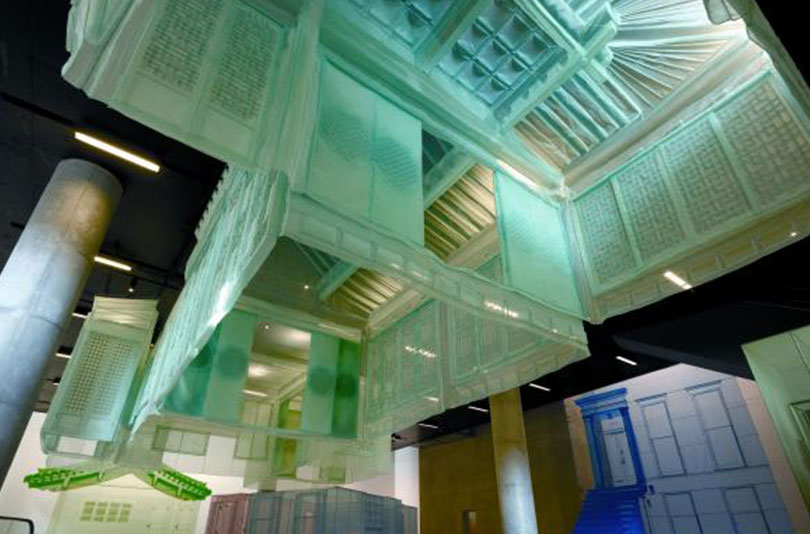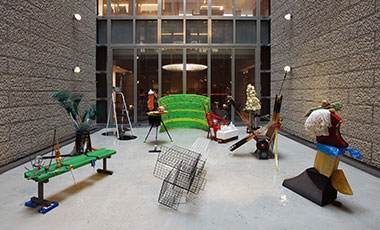In celebration of the publication of TheArtro, it has conceived a special column called 'Art Talk' in which a domestic exhibition that has recently attracted much attention in the Korean art scene is examined from a variety of angles. Its first subject is (Do Ho Suh - Home within Home) , a solo exhibition of Suh’s artworks, which made a spectacular stir in the Korean art scene in the first half of 2012. This exhibition was Suh’s individual show that was presented after the lapse of almost a decade in Korea since his show in 2N3 at Arlsonje Center. The exhibition featured about forty works by Suh in various forms including sculpture, video art and drawing while focusing on one of Suh’s main creative motifs, ‘Home,’ through which Suh has been highly esteemed in the intemational art scene and which has been embodied in his works of the Seongbuk-dong hanok, his past residences in New York and Berlin. Here in this ArtTalk, the exhibition is observed by an architect, an art critic and a design cultural critic from their own articulate points of view.
Written as Home and Read as "집"
The Korean equivalent of two different English words, ‘house’ and ‘home’ is ‘집[Jip]', one word that is used to describe both. I wanted to look into 《Home within Home》 by directing my attention to the difference between a house and a home, or by taking our attitude to use the same word ‘집’ to refer to both. In a dictionary, a house is defined as a building that serves as living quarters for one or more families emphasizing its physicality, and a home is as the place where one lives, especially as a member of a family or household stressing its emotional factor. Yet we use the same word ‘집’ to express both. Provided that, what does 집 mean to Suh and why has he chosen to use the word, ‘home’?
The first sketches displayed in the gallery gave me some clue to such decision of Suh. From the cradle to the grave we spend a considerable part of our lives in the spaces of our houses. In those spaces occur our daily routines: waking up, eating, entertaining, sleeping and so on. Also, it is a house for an individual to live comfortably together with the others - we call them family members. To Suh’s understanding 집 is a home through which an individual’s memories are triggered by its space to be recalled and to be re-experienced. As ways to express his own experiences, Suh employs the elements of architecture including perspective drawings, elevation and cross-sectional views and two-dimensional sequence drawings. In these sequence drawings, Suh shows the interiors of the houses where he has dwelled. Probably, for him, these spaces are not of a mere sequence of the rooms in the houses but of a succession of his own memories about the live she had in those rooms. It is a matter of course that an individual’s sequences of memories are accumulated to form his or her life or identity. Together with the person in front of the drawing who is about to walk into the house, we can enter into his memories of his houses in which he has led his life. Needless to say, what we imagine as we stroll through is unquestionably different from Suh’s memories. Nevertheless, we can allow ourselves to envision what happened there or would have happened by weaving our memories into the artist’s spaces. It can be said that this bears a resemblance to one’s attempt to understand the other through his or her self-reflection. Maybe, it is the first step to communication.
The sketches facilitate us to share the memories of the other who is different from us and to entertain ourselves by letting us to communicate with our own memories, and they are more concretized in the installation works of the houses made of fabrics displayed within the same exhibition space.
 Do Ho Suh_Seoul Home / Seoul Home
Do Ho Suh_Seoul Home / Seoul Home
Regarding these homes, "It is not that they are homes made of fabrics but that the homes are dressed, and I used transparent fabrics to materialize those memories, which are intangible that slip through the cracks of our fingers." said Suh. Having perceived 집 as a home through which he has retained his personal memories, Suh has now presented them in the form of a concrete entity of a house. Suh produced physical ‘houses’ by utilizing translucent cloth and an exceptionally delicate method. Having comprehend 집 as a home, he used semitransparent fabrics to metaphorize impalpable and insubstantial memories. That is to say, Suh has concretized the two disparate notions of 집 - a physically oriented house and a mentality - oriented home - through 집 of dual meaning, namely, a house made of cloth. To Suh who grew up in this land of Korea and believes in his Korean identity, a house is not a dichotomic space of physicality and mentality but a building as a single undivided entity. Provably for he understands it as an interior space of a building sometimes and at other times as the life in that space.
Meanwhile, Suh proposes another intriguing perspective towards 집 through his fabric houses, which are the combination of a physical substance and an affectional entity. In front of his other works of 집 exhibited on the second floor, we realize the houses cherished by his memories start to move.
 Do Ho Suh_Fallen Star-1/5thScale
Do Ho Suh_Fallen Star-1/5thScale
Perhaps, the past houses are on their way to the present houses. These are physical houses, and they are being transported through physical mediums: human bodies, wheels attached to them, or parachutes. Likely as not, the transportations of the past houses have already completed. They have arrived in the present spaces and must have been collided with or integrated into the present houses. Back to the fabric houses, however, they, which has by now been formulated by the equation of ‘house=home’, have become portable to be folded easily to be carried with the artist. The fabric houses of physicality are incorporated into those of mentality so as to converse with the fresh spaces while being quietly absorbed into those new spaces.
If one may say that an architect designs a house to be a background for memories or memories themselves, Suh seems to convey through his works shown in this exhibition that a house not only contain and hold the space for one’s daily life but exerts an immense impact on his or her life functioning as part of his or her memories, which originate from the accumulation of his or her daily days or as a medium through which he or she is prompted to recollect them. Suh discovers a home in a house and enlightens us who are subject to constant collision with, influence by and reconciliation with society located outside the house on the fact that our memories of our ‘home + house’ form ‘us as ourselves’. In this respect, one can safely assume that the exhibition deserves its title of ‘Home within Home,’ not ‘House within House’.
Do Ho Suh - Home within Home
Written as "Home" and Read as "집" _ Kang Jungeun(Architect)
Suh Do Ho: Transparent and Open Spaces "This potable Korean house is my parachute" _ Lee Daebum(Art critic)
Home within Home_Globalization, Identity and the Mind _ Helen Cho(Design cultural critic)

Kang Jungeun / Architect
Having been aspired for building architectures from her childhood, Kang Jungeun majored in architecture in college. While gaining experiences in practical aspects of architecture, she realized her more intensely grown interest in architecture and city planning. This led her to go to Europe to study urbanism, that which was rewarded by her reception of a European postgraduate master's in urbanism. Yet she concluded to believe in architecture and pursue a career as an architect and has returned to Korea. She is living the year 2012 while seeking after an answer to what a good building should be in this 'together' world.


